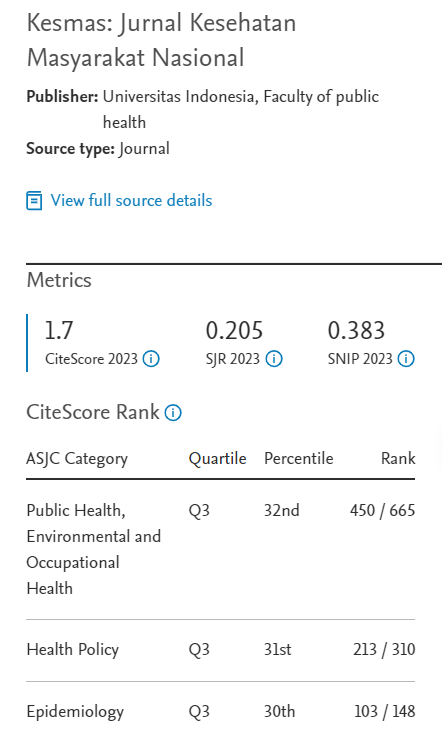Abstract
Bensin dengan kandungan logam berat timbal digunakan sebagai bahan bakar utama kendaraan bermotor di Indonesia sejak beberapa dekade. Jakarta, Batam dan Bali yang secara berurutan sudah tidak menggunakannya sejak 2001, 2003 dan 2004. Pengaruh negatif logam berat timbal meliputi penurunan tingkat IQ, gangguan pendengaran, gangguan pertumbuhan, dan menurunkan kadar hemoglobin, masih akan terus berlangsung dan mengancam anak-anak. Studi kadar logam berat timbal dalam darah di Jakarta, tahun 2001, menemukan 5% anak sekolah dasar dengan kadar timbal darah (BLLs) >10 µg/dl, dan 2,4% mempunyai BLL > 20 µg/dl (CDC-USAEP 2001). Penelitian ini bertujuan menilai kadar timbal darah anak sekolah dasar di Jakarta, tahun 2005. Studi dilakukan pada anak-anak sekolah dasar kelas 3 dan 4 di Jakarta pada periode Januari-Februari 2005. Sebanyak 20 sekolah dasar yang terpilih dan 203 pelajar berartisipasi pada penelitian. Rata-rata kadar hemoglobin darah adalah 12,6 g/dl dan kadar Pb darah adalah 4,2 µg/dl. Proporsi anak-anak dengan kadar Pb-darah >10 µg/dl adalah 1,3%. Penurunan prevalensi Pb-darah dari studi tahun 2001 secara meyakinkan merefleksikan keberhasilan program penghapusan bensin bertimbal di Jakarta. Itu berarti bahwa program tersebut berhasil mencegah pajanan risiko toksik dan dampak kesehatannya pada penduduk Jakarta, khususnya anak-anak. Program penghentian bahan bakar bertimbal disarankan untuk diperluas pada seluruh provinsi dan kota di Indonesia.
Leaded-gasoline has been used as major octane booster of motor vehicles’ gasoline in Indonesia since decades ago, except in Jakarta, Batam and Bali where it had not been used from 2001, 2003 and 2004, respectively. Negative effects of lead, such as decreasing of IQ, hearing, growth, and hemoglobin level, then will still be threatening and may continue in the future. Meanwhile, the prolonged lead exposure occurs in the may have more dangerous human health effects to children. The Jakarta blood-lead study in 2001 showed that 35% elementary school children have blood lead levels (BLLs) more than 10 µg/dl, and 2.4% had BLL more than 20 µg/dl (CDC-USAEP 2001). The objective of this study is to assess the blood lead level of elementary school children in Jakarta urban area in 2005 by evaluating the mean blood lead level of 3rd and 4th grade elementary school children in Jakarta urban area. A cross-sectional survey was implemented to achieve the above objective. The study was conducted in January-February 2005. Portable LeadCare and Hemocue were used to analyze blood-lead and blood hemoglobin (Hb) respectively from children finger blood on site. All of the 20 selected elementary schools agreed to participate in the test. A total of 203 students were allowed by their parents to participate in the test. The overall average for Hb-blood level is 12.6 g/dl and for Pb-blood level is 4.2 µg/dl. Percentage of those children with Pb-blood equal and more than 10 µg/dl is 1.3%. The declining Pb-blood prevalence from 2001 study obviously reflects the success of Leaded-gasoline phase-out program in Jakarta. It means that the program is successful in preventing people exposed to leaded gasoline in Jakarta, especially children, from the risk of lead toxicity and its impacts. Thus, the program of phasing-out of leaded-gasoline should be expanded and implemented to all Indonesian provinces and cities in order to avoid lead exposure to people.
References
- ADB. 2000. Technical Assistance for Action Plans for Reducing Vehicle Emissions. Manila.
- World Bank.1994. Report No 12083-IND: Indonesia Environment and Development: Challenges for the Future. Washington.
- CDC (November, 1997). Screening young children for lead poisoning: guidance for state and local public health officials, U.S. Department of Health and Human Services, Public Health Service.
- CDC (1991). “Preventing Lead Poisoning in Young Children: A Statement by the Centers for Disease Control.” Report No. 99-2230, Atlanta, GA: CDC, US Department of Health and Human Services, 1991.
- WHO (1987). Air Quality Guidelines for Europe. Geneva, WHO Publications.
- CDC (1997). Screening young children for lead poisoning: guidance for state and local public health officials, U.S. Depart. of Health and Human Services, Public Health Service.
- WHO (1995). Inorganic Lead. Geneva, WHO.
- Haryanto, B. (2003). “Gasoline Health Effects: Considerations for Public Policy Development.” Proceeding of ENVIROTECH-2003 Regional Workshop on Integrated Vehicle Emission Reduction Strategy, Jakarta, October 2003.
- Achmadi, UF, et al (1978). “Kadar timbal darah pengemudi bis, taksi, dan bajaj di Jakarta 1978” Majalah Widiapura, Jakarta, 1978.
- Fardiaz, S. (1992). Polusi Air dan Udara, Penerbit Kanisius Yogyakarta
- Albalak R, Noonan G, Kim D, Buchanan S, Blumenthal W, et al.(2001). Lead Exposure and Anemia among Children in Jakarta, Indonesia. Report. Center for Disease Control and Prevention in collaboration with the United States Environmental Protection Agency .
- Haryanto, B. (1993). Profil Pb Dalam Darah Perokok yang Bekerja di Daerah Padat Lalu Lintas di Kotamadya Bandung Tahun 1992. Tesis. Jurusan Kesehatan Lingkungan FKM. Depok, Universitas Indonesia.
- Zink, E., Cullison, J., Bowers, ML., Wegner, SE., Naser, N., O’Daly, J., et al. (1997). Review of the performance characteristics of the Lead Care blood lead testing system, ESA Inc. 1997.
Recommended Citation
Haryanto B .
Blood-Lead Monitoring Exposure to Leaded-Gasoline among School Children in Jakarta, Indonesia 2005.
Kesmas.
2007;
1(5):
214-218
DOI: 10.21109/kesmas.v1i5.293
Available at:
https://scholarhub.ui.ac.id/kesmas/vol1/iss5/4







